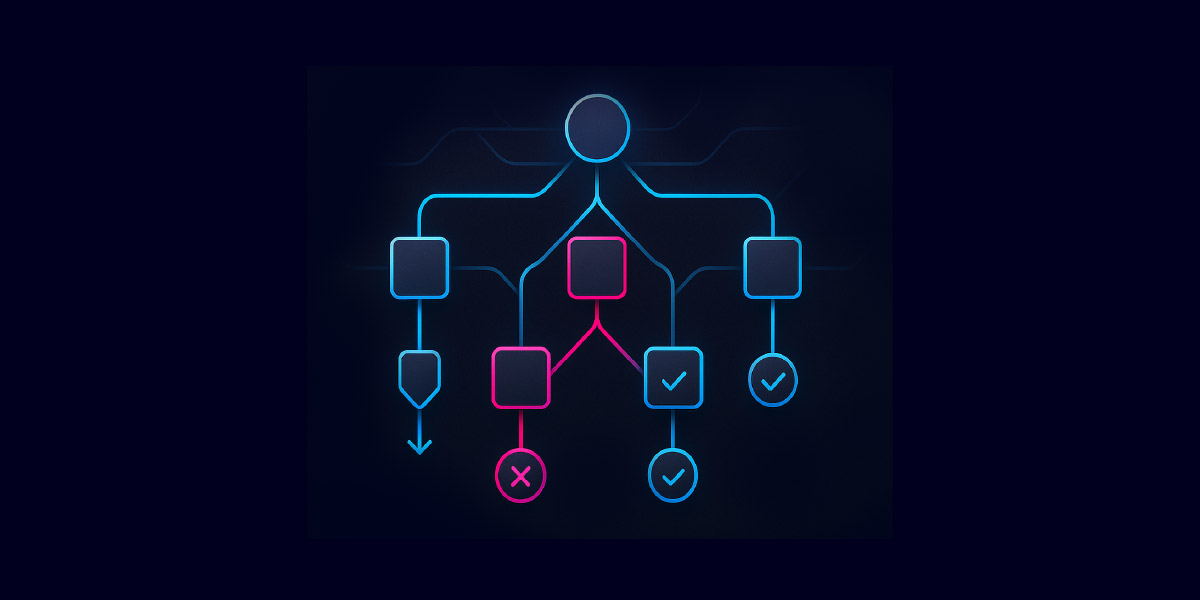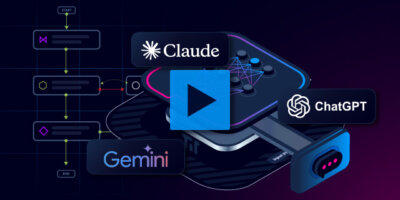Share this

Table of Contents
- The Executive Reality
- From Rules to Reasoning
- Deterministic vs. Reasoned: Clear Definitions
- How Itential Supports Both Deterministic & Reasoned Automation
- The Missing Middle: Atomic Actions
- Deterministic Automation: Strength in Certainty
- A Hybrid Model, Not a Replacement
- AI as a Factory for Deterministic Actions
- Reasoning Within a Trust Envelope
- Thinking & Doing: The Right Division of Labor
- Real Scenarios, Real Impact
- The Role of Itential
- The Hybrid Model in Motion
- Implementing the Model
- Agentic Orchestration: Putting AI Reasoning to Work
- The Road Ahead
The Executive Reality
Executives don’t need another “AI will change everything” promise. You need a practical path to integrate AI into your automation without losing control or compliance. The future isn’t replacing deterministic automation with AI – it’s using AI to create deterministic building blocks that orchestration can trust, validate, and reuse at scale.
This hybrid model – reasoned decision-making combined with deterministic execution – is how enterprises move beyond brittle scripts toward intelligent, governed automation.
Itential enables this shift by providing the structure: workflows, policy enforcement, validation, and auditability that make AI operational at enterprise scale.
From Rules to Reasoning
Automation has evolved from artisanal scripting to cross-domain orchestration. Deterministic systems built on rules and templates gave enterprises predictability and speed, but as architectures fragmented and change velocity increased, rigid workflows struggled with real-world complexity. Meanwhile, AI reasoning models can synthesize context, weigh tradeoffs, and propose actions dynamically. The promise is compelling, but so is the risk. The solution is balance: deterministic automation for control, AI reasoning for adaptability: both governed together.
Deterministic vs. Reasoned: Clear Definitions
Let’s anchor terminology the way your leadership team can align on:
Deterministic
Workflows or code that execute prescribed instructions to accomplish a goal. Given the same input and state, you get the same outcome – predictable, testable, auditable.
Reasoned
Outcomes inferred by an LLM or AI agent from contextual data provided via prompts, agent definitions, or tools. The system analyzes intent and evidence, proposes options, explains trade-offs, and recommends a course of action.
Thesis: The future isn’t “AI versus automation.” It’s AI that creates and selects deterministic building blocks and orchestration that executes them under policy.
How Itential Supports Both Deterministic & Reasoned Automation
Enterprises need more than a bridge between deterministic and reasoned systems – they need a fabric that governs both with confidence. Itential’s orchestration platform is designed precisely for this role. It doesn’t replace one with the other, it operationalizes both in harmony.
For Deterministic Automation (Control & Certainty)
- Governed Execution: Ensures all workflows follow policy, RBAC, and approval chains.
- Pre- and Post-Validation: Built-in checks, rollbacks, and simulations guarantee predictable outcomes.
- Action Registry: Houses signed, versioned atomic actions for safe, reusable automation.
- Auditability by Design: Every change, approval, and validation step is recorded and traceable.
- Policy Enforcement: Deterministic workflows always execute within security and compliance boundaries.
For Reasoned Automation (Adaptability & Insight)
- AI Integration Points: Allows reasoning engines or LLMs to analyze telemetry, generate atomic actions, and propose change options.
- Policy as a Boundary: AI operates inside defined policies; proposals are evaluated before actuation.
- Explainability & Rationale Capture: AI outputs include context, reasoning, and confidence scores for human validation.
- Closed-Loop Feedback: Post-change results feed back into reasoning systems to improve recommendations.
- Human-in-the-Loop Governance: Risk-based approvals allow AI-assisted automation without sacrificing oversight.
Together, these capabilities let enterprises trust AI-generated recommendations while preserving deterministic assurance. Itential becomes the connective tissue between intelligence and control: the fabric where reasoning meets safe execution.
The Missing Middle: Atomic Actions
Most enterprises jump straight from “AI proposes an idea” to “orchestration makes a big change.” The gap in the middle is an action contract – small, reusable units of change we can trust.
Atomic actions are those units:
- A script, playbook task, API call, Lambda function, Terraform module, CLI command, or vendor-specific configuration snippet.
- They are idempotent, parameterized, and self-verifying with pre- and post-checks.
- They declare inputs, outputs, side effects, rollback, and expected exit codes.
- They can be linted, tested, signed, versioned, and approved – then reused across many flows.
Think of atomic actions as the Lego bricks of safe automation. AI with Itential can help design and produce the bricks, while your orchestrator assembles them to deliver business outcomes.
To make those bricks truly reusable and trustworthy, enterprises need more than just code generation – they need lifecycle management. That’s where Itential steps in.
How Itential Supports Atomic Actions
Atomic actions are only as valuable as the system that governs, validates, and reuses them. Itential provides the secure foundation that turns these small, deterministic building blocks into an enterprise-scale capability.
- Action Registry & Version Control
Itential maintains a curated Action Registry, a central catalog of approved atomic actions. Each action is signed, versioned, and linked to provenance data, so only validated artifacts are used in production. This transforms individual automation scripts into reusable, auditable assets. - Policy-Governed Execution
Before any atomic action runs, Itential enforces policy gates – RBAC, compliance checks, naming standards, and change windows – to ensure every action aligns with organizational rules. Even AI-generated actions must pass deterministic validation before orchestration. - Validation & Simulation Built In
Itential integrates pre-checks, post-checks, and dry-run simulations directly into workflow steps. Atomic actions are executed in safe environments first, with results logged for comparison against expected outcomes before live deployment. - Seamless Orchestration & Composition
Atomic actions aren’t standalone scripts; they’re the building blocks that Itential orchestrates across domains. Through low-code workflows, they can be combined into larger, multi-domain automations (network, cloud, security, ITSM) without brittle glue code. - Closed-Loop Feedback & Reuse
Each executed atomic action generates telemetry, compliance evidence, and change data that feed back into Itential’s system. Successful, validated actions are promoted for reuse, while drift or errors inform future improvements. This makes automation safer and smarter over time.
In short: Itential doesn’t just run atomic actions, it governs their lifecycle from creation to execution. AI with Itential can design them; Itential makes them trustworthy, reusable, and compliant at scale.
Deterministic Automation: Strength in Certainty
Deterministic automation remains the enterprise backbone because it delivers predictability, auditability, and operational safety. When inputs are known, outcomes are consistent – a necessity for compliance and repeatability. Templates, pre- and post-checks, and well-tested runbooks reduce failure and make rollbacks simple. These systems scale routine work, eliminating manual toil.
Yet their limits appear when context changes or exceptions occur. Deterministic logic cannot easily reason through state variations or multi-causal failures. As automation becomes mission-critical, it needs judgment and context – capabilities AI provides.
A Hybrid Model, Not a Replacement
The future is not AI versus automation. It’s AI that generates deterministic components validated and executed by governed orchestration. Most enterprises jump from “AI proposes” to “orchestration executes,” missing the layer in between: the action contract – small, reusable, deterministic units of change called atomic actions. Each atomic action – whether a script, API call, IaC module, or CLI command – is parameterized, self-verifying, and testable. When versioned and approved, these become the Lego bricks of safe automation. AI with Itential can design and improve them; Itential orchestrates them under policy.
AI as a Factory for Deterministic Actions
AI becomes powerful when treated as a code and action generator inside a secure pipeline. It can produce scripts and playbooks with validation built in, serverless functions for remediation, configuration snippets aligned with policy, or Terraform modules that encode golden baselines.
A secure action supply chain ensures everything AI creates is safe to use:
- Generate: AI drafts atomic actions based on standards.
- Validate: Linting, testing, schema checks, and security scans.
- Apply Policy: Automated compliance checks for naming, permissions, and cost caps.
- Simulate: Dry-run in sandbox environments.
- Review: Human + AI validation.
- Sign & Publish: Provenance and versioning.
- Orchestrate: Itential executes only trusted actions.
AI speeds creation; orchestration guarantees safety.
Reasoning Within a Trust Envelope
Reasoning systems complement deterministic workflows by handling ambiguity and synthesizing signals. They ingest telemetry, logs, and tickets, evaluate hypotheses, and translate human intent into structured, validated actions. In practice, AI with Itential can triage incidents, generate compliant configurations, or predict change risk faster than humans. Yet AI without guardrails risks hallucination, policy breaches, and compliance drift.
Enter the trust envelope – the mechanisms that make AI operationally reliable:
- Policy-first governance ensures AI operates within explicit boundaries.
- Validation before actuation uses simulation and testing to prevent unsafe changes.
- Explainability and provenance make every recommendation reviewable.
- Observability and feedback verify results and improve future reasoning.
- Least-privilege execution ensures AI with Itential cannot act outside its scope.
These are the checks that turn AI from an assistant into a trusted component of production automation.
Thinking & Doing: The Right Division of Labor
A durable hybrid model separates reasoning from execution.
AI interprets intent, proposes and ranks actions, and recommends the smallest-blast-radius plan.
Deterministic orchestration executes approved atomic actions, enforces validation and rollback, and maintains audit trails.
AI decides what to do. Orchestration ensures how it’s done – safely and repeatably.
This structure also provides accountability. It prevents unbounded actuation while ensuring faster, context-aware decision-making.
Real Scenarios, Real Impact
In incident remediation, AI correlates telemetry, generates deterministic fixes, and Itential orchestrates rollout with validation and rollback.
For compliance drift, AI creates remediation packs, while orchestration enforces rollout with audit evidence.
In cloud provisioning, AI assembles Terraform modules and Itential ensures compliance.
During certificate rotation, AI generates vendor-specific actions, and orchestration executes them safely in batches.
Across all, AI creates or adapts deterministic actions, and Itential validates, governs, and executes them under policy.
The Role of Itential
Itential is the governed automation fabric where reasoning meets execution. Its low-code workflows connect network, cloud, and IT systems while enforcing policies, validation, and rollback. Signed, reusable atomic actions ensure safe reuse. Data transformation translates AI outputs into vendor-specific actions without brittle scripts. Closed-loop verification guarantees that every change is auditable and trusted.
Itential doesn’t try to be the AI – it makes reasoning operational.
The Hybrid Model in Motion
The winning architecture is a deterministic core with a reasoned edge.
The core handles orchestration, guardrails, and compliance; the edge adds AI-driven insights at decision points. The execution loop follows a steady rhythm: AI proposes, deterministic checks validate, risk-based approvals authorize, orchestration executes, and verification refines. It’s AI as co-pilot – hands on the map, not the wheel.
Governance ensures control: reasoning chooses, orchestration executes, and policy governs. Least-privilege access prevents overreach, and every step is logged for transparency. Over time, trust grows as validated performance allows controlled expansion of automation.
Implementing the Model
Adopting this model doesn’t require a moonshot. Start by defining policies, roles, and approval thresholds. Instrument your environment to provide high-quality data. Choose bounded use cases – incident triage or drift remediation – and insert AI at decision points, not execution layers. Validate everything through pre-checks and simulation. Apply human-in-the-loop approvals by risk level, capture outcomes, and scale horizontally across domains. This evolution happens in quarters, not years.
Success metrics are practical: faster mean time to resolution, lower failure rates, fewer compliance drifts, healthier action registries, and more time spent designing versus firefighting. Tie these gains to business outcomes to keep leadership aligned.
Agentic Orchestration: Putting AI Reasoning to Work
With Itential, this hybrid model becomes a natural progression into agentic orchestration. AI agents reason over telemetry, tickets, and topology, then propose the smallest-blast-radius plan in the form of deterministic atomic actions. Through Itential’s orchestration fabric that enables integration with services and tools, those agents are constrained by policy, approvals, and validation, ensuring they cannot act outside of a defined, trusted context envelope. The result is an operating model where agents decide what should happen, and Itential ensures how it happens is secure, compliant, and fully auditable.
The Road Ahead
The industry is moving toward intent-driven operations, where executives express outcomes, AI translates intent, and orchestration executes within policy. Full autonomy will come progressively, built on evidence and validation. Itential’s role is to make that evolution safe, governed, and actionable.
You don’t have to choose between control and intelligence. Use AI with Itential to create deterministic, validated actions and orchestrate them through Itential’s governed platform. That’s how you scale intelligent change without sacrificing safety. Leaders who adopt this model accelerate delivery, reduce risk, and turn AI into a trusted production advantage. The path forward is clear: reasoned decisions, deterministic execution, provable outcomes.



